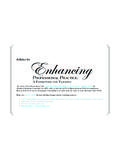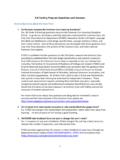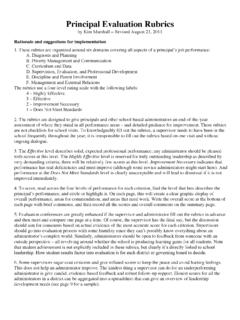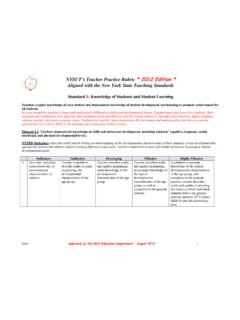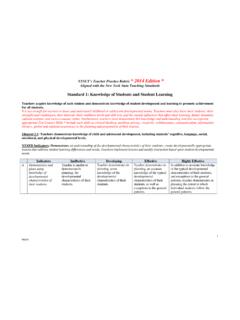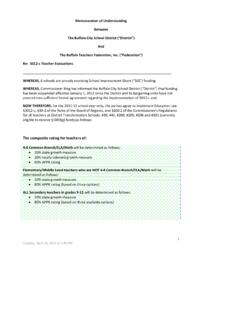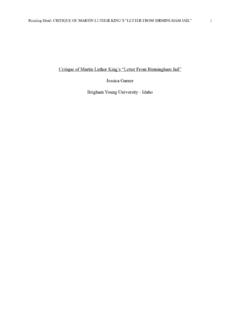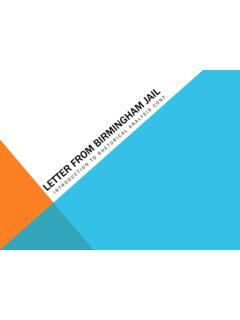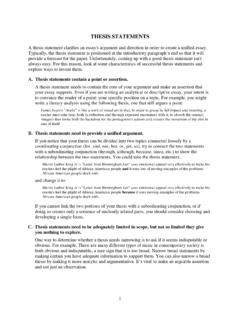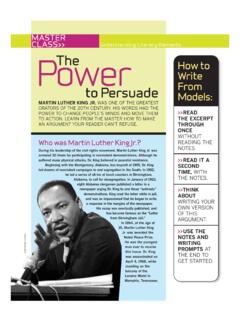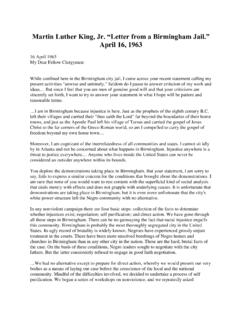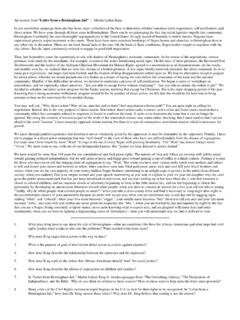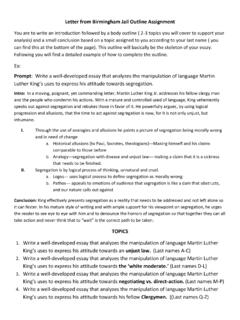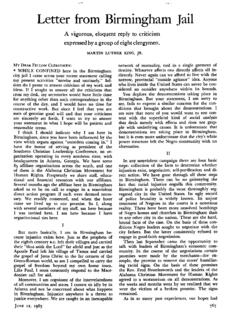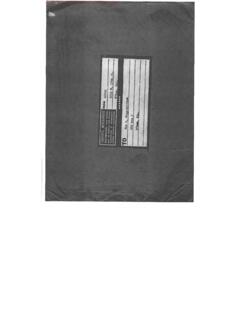Transcription of Bringing the Common Core to Life David Coleman · Founder ...
1 1" Bringing the Common Core to Life" David Coleman Founder , Student Achievement Partners Chancellors Hall State Education Building Albany, NY April 28, 2011 Part 6 Discussion of Common Core State Standards for ELA & Literacy and letter from a birmingham jail by Dr. Martin Luther King, Jr. David Coleman Hopefully, some of you who prepared for this conversation today took a look at King's letter from a birmingham jail and I d like to tell you what I'm going to try to do with you over approximately the next 20 minutes with that letter .
2 What I m trying to do is to show you what instruction begins to look like with the core in mind. And, of course, that begins to address the very good question asked me earlier, which was What s the difference? How does instruction on a day-to-day basis in a way a teacher looks at it, in the daily choices a teacher makes look different when confronted with the core? The time within which we are discussing this, 20 minutes, is highly elusory because I think teaching this letter is at least six days with maybe another week with a comparison we ll talk to you about.
3 But we just did a body of work, a team and I built up an exemplar around the Gettysburg Address, which as you know is three paragraphs long, and it is for three days of instruction on those three paragraphs and that is not by Bringing in other resources yet. That s by focusing on the text itself. The first major shift I want you to consider is far longer amounts of classroom time spent on text worth reading and rereading carefully, a kind of diligent close attention. This has several implications.
4 It also means that a much wider range of kids are in on the game. It means that you can chunk into smaller parts anything but avoiding the richness and complexity. So while I ll speak to you only for 15 or 20 minutes about the letter , please see it as the beginning of six days of instruction rather than this brief talk. Finally, I know there s an issue hanging in everyone's mind, which is for what range of students is this really possible a letter like this?
5 These are just my best students who can read King s letter . And I want to challenge you today that our core challenge as a community and this is hard work but work worth doing is to get all kids so that after 12 years of practice they can read a text like this with confidence. This IS what college and career readiness demand. This text is precisely at that level. This IS our shared challenge. And there can be intensive support and scaffolding and additional practice to do it but this is the work of doing it.
6 And, strangely, I want to suggest to you that while this text is complex I would dare to argue that reading is fairly simple, that there is no reason to make more complicated than it is the task of teaching reading, of paying close attention, of gathering evidence from what you read. So I might ask 2you to forgive me because I'm worried that you re going to find what I'm about to do far too straightforward for most experts, but far more like the core of instruction for what we must do when facing something difficult.
7 So the question that faces us when we look at the letter from birmingham jail , and I will return by the way to how do we do this for a wide range of students, is how do we begin? This is a great question for an artist when they're beginning something or for a teacher. And I thought I would begin by making myself as unpopular as possible by attacking the three most popular ways of beginning. The most popular way first, I should give you background information and an account of the letter before we begin so you can get oriented.
8 There was a great man, Dr. King. He wrote a letter while in jail because a set of clergymen had sent him a letter saying he should slow down. This is his ringing defense of nonviolence, of the distinction between just and unjust law. We shall read it to together, etc. What you have effectively done as a teacher when you do this is you ve replaced the letter from birmingham jail with a simpler text, your summary, that now kids will quote back to you. And because of the overwhelming power of self love, those answers are of course correct.
9 Kids are very artful at this. So that s the first escape from the text is to summarize it in advance. You would be stunned in curricular materials how often a text is trivially summarized before it begins. If this is all King had to offer were those conclusions, we should not do the work of reading the letter altogether. Number two, pre-reading strategies. So then there s a lot of work you can try to do before the letter like you might try to predict what he s going to say or where he was or you might try to compare it to other prison letters.
10 You might to try to do several pre-reading type approaches. Forgive me, but I am asking you to just read. To think of dispensing for a moment with all the apparatus we have built up before reading and plunging into reading the text. And let it be our guide into its own challenges. That maybe those challenges emerge best understood from the reading of it. And that maybe we don t have to force a whole set of additional activities that prepare you to start. I ll give further examples of this later.
